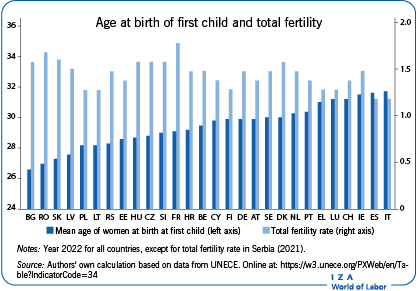Elevator pitch
Increasing population age and low fertility rates, which characterize most modern societies, compromise the balance between people who can participate in the labor market and people who need care. This is a demographic and social issue that is likely to grow in importance for future generations. It is therefore crucial to understand what factors can positively influence fertility decisions. Policies related to the availability and costs of different kinds of childcare (e.g. formal care, grandparents, childminders) should be considered after an evaluation of their effects on the probability of women having children.

Key findings
Pros
Increased availability of formal childcare is associated with higher fertility rates, particularly for first births.
Reducing childcare costs can significantly boost fertility rates by making child-rearing more affordable.
Grandparents play a crucial role in childcare, positively influencing both maternal employment and fertility.
Formal childcare is associated with positive effects on children’s cognitive and non-cognitive development, supporting its promotion.
The availability of immigrant childminders can increase fertility among highly educated women by reducing childcare burdens.
Cons
Maintaining high-quality formal childcare is expensive, which can limit its availability and accessibility.
Variation across different geographic contexts makes the relationship between childcare availability and fertility ambiguous.
The lack of comprehensive data on the availability and costs of childminders makes it difficult to assess their impact on fertility decisions.
The reliance on grandparents for childcare introduces significant endogeneity problems, as the decision to use grandparents’ care is often internally determined within families.
Better childcare availability may lead women to work more, which could paradoxically reduce their likelihood of having more children.